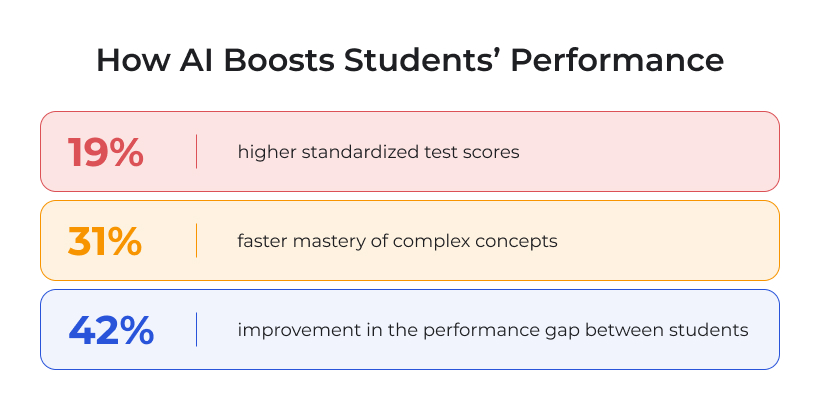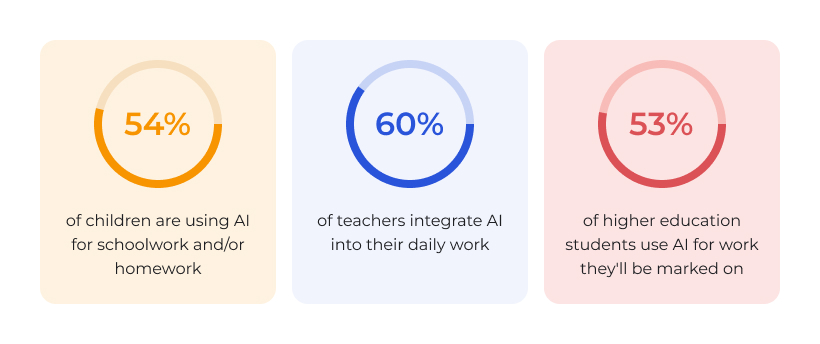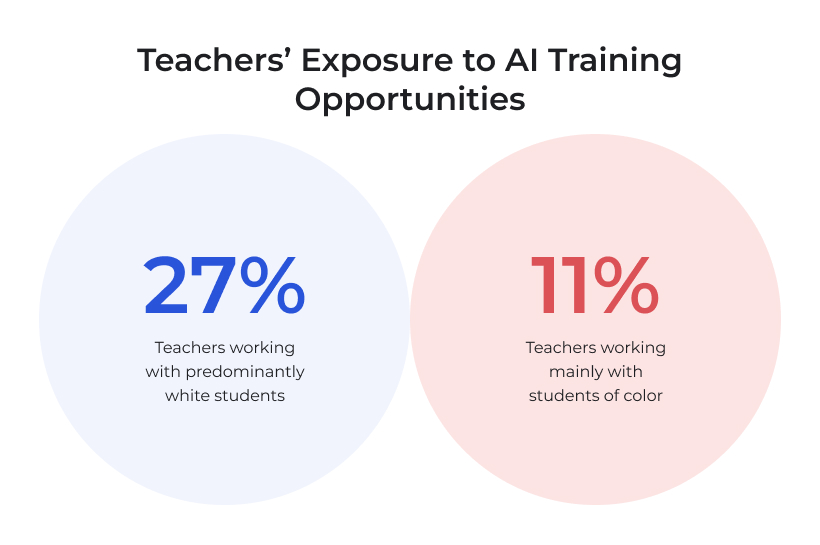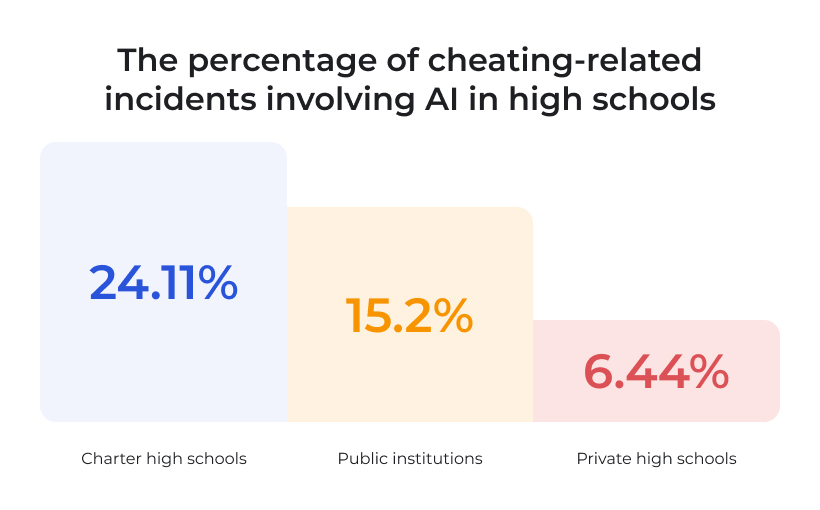In 2025, there’s no such question as “Whether or not to implement AI in education”. While the older generation has a debate over practicability, ethics, price, and the complexity of technical execution, the youngsters are actively using ChatGPT, DALL·E 2, DesignScape, and a myriad of other AI-powered tools to study, complete assignments, and fuel their hobbies.
The survey by AIPRM shows that today 44% of children are active users of AI and it’s safe to assume that this percentage will grow day-by-day globally as technology becomes more accessible. So, both parents and business owners working in Education have to accept the fact that the industry has already changed and children will educate themselves via AI. The real problem here is whether we’re going to try and make it safer and more fruitful or not?
This article is aimed to help decision makers, startuppers, and entrepreneurs get a better understanding of which common pitfalls are waiting for them on the way of integrating AI in online education and which benefits to expect upon successful implementation. We’re providing a comprehensive overview of the potential pros and cons, so you could build a sustainable strategy and wouldn’t be discouraged along the way.
So, without further ado, let’s start with the good part!
Benefits of Implementing AI in Online Education
AI is a powerful tool that can enhance the learning environment in several ways. Let’s explore the key benefits.
Boost of Engagement
One of the primary challenges in online education is student engagement. With the absence of face-to-face interactions, students often feel disconnected from their instructors and peers, which can lead to lack of motivation. AI can help bridge this gap by offering personalized learning experiences that keep students engaged.

AI-powered tools such as adaptive learning systems adjust content to match the individual learning pace of each student, ensuring that they are neither overwhelmed nor under-stimulated. AI can also enhance engagement through gamification, where learning modules are designed in a more interactive and fun way, encouraging students to participate more actively. Chatbots, powered by AI, can answer students’ questions in real-time, making the learning experience feel more responsive and interactive.
Improved Students' Performance
AI can significantly impact student performance by personalizing learning paths based on individual needs. Traditional education systems often rely on a one-size-fits-all approach, but AI allows for tailored lessons that adapt to the strengths and weaknesses of each student.

For example, AI can analyze data from students’ past performance to determine the areas where they may be struggling. It can then recommend personalized resources and exercises to help them improve in specific areas, which can lead to better retention rates and overall academic success. Additionally, AI can provide immediate feedback, allowing students to correct mistakes or gain a better understanding of a concept without waiting for feedback from an instructor.
Simplifying the Workflow for Education Facilities
In educational institutions, administrative tasks such as grading, scheduling, and record-keeping often consume a significant amount of time and resources. AI can simplify and automate many of these processes, freeing up educators to focus more on teaching and less on routine tasks.

For instance, AI-based grading systems can automatically grade assignments and exams, offering not only speed but also objectivity in evaluation. These systems can also provide instant feedback to students, enabling them to learn from their mistakes more efficiently. Additionally, AI can help streamline communication, ensuring that students receive timely updates about their coursework, schedules, and assignments, without requiring manual intervention from instructors or administrative staff.
Better Accessibility
AI can help overcome some of the barriers that prevent certain students from accessing quality education. This is particularly important for students with disabilities or those in remote areas where educational resources are limited.
AI-powered speech-to-text and text-to-speech systems can make learning materials more accessible to visually impaired or hearing-impaired students. Moreover, AI can facilitate real-time translations, helping students who speak different languages to access content in their native language. AI can also create personalized learning experiences for students with special educational needs, making it easier for them to learn at their own pace and receive tailored support.
Assistance with Evaluation and Grading
In traditional education systems, grading and evaluating students can be a time-consuming and subjective process. AI-powered tools can assist in automating these tasks, ensuring consistency and accuracy. AI can evaluate assignments, essays, and even coding projects, providing a level of objectivity that human graders may struggle to achieve.
Beyond grading, AI can track student progress over time and predict future performance based on data. This predictive analysis can help instructors identify students who may need additional help before problems escalate, ultimately leading to better academic outcomes.
Challenges of Implementing AI in Online Education
While the benefits of AI in online education are clear, the technology also comes with significant challenges. Below are some of the primary obstacles that institutions must consider.
Unequal Technology Access Levels
One of the most significant challenges in implementing AI in online education is the digital divide. Many students around the world still lack access to high-quality internet, modern devices, and other necessary technologies. For AI-driven platforms to work effectively, they require robust hardware and internet connectivity.

In regions where technology access is limited, AI solutions may be less effective or completely unusable. This creates inequalities in education, particularly for students in low-income or remote areas, and can deepen the gap between those who have access to advanced education and those who do not.
Implementation Costs
Implementing AI-driven systems in online education can be a significant financial investment. For many educational institutions, especially those in developing countries or smaller private institutions, the cost of integrating AI technologies can be prohibitive.
These costs include purchasing AI software, updating hardware, and providing training for educators to effectively use these tools. Additionally, there are ongoing maintenance and operational costs that come with keeping the system running efficiently. These barriers can prevent many institutions from fully adopting AI, even if they recognize the long-term benefits.
Poor Digital Literacy
While AI in education can be highly effective, its implementation requires digital literacy both from teachers and students. Many educators may not be familiar with AI technologies, and without proper training, they may struggle to fully leverage AI tools in the classroom.
Similarly, students must have a certain level of digital competency to effectively interact with AI-powered platforms. Without adequate training or support, there is a risk that students will either not engage with the technology or misuse it, limiting the effectiveness of AI in their learning experience.
The Risk of Overdependence on AI
Another significant challenge is the potential for overdependence on AI systems. While AI can enhance learning, it cannot replace the human element of teaching. There is a risk that over-reliance on AI could result in a loss of critical thinking, creativity, and personalized student-teacher relationships that are essential for holistic learning.

AI is a tool that should assist educators, not replace them, and maintaining a balance between technology and human interaction is crucial to ensuring effective education.
Data Privacy Concerns
AI systems rely heavily on data, including sensitive student information such as academic performance, behavior patterns, and personal details. This raises significant data privacy and security concerns. Educational institutions must ensure that they adhere to strict data protection laws and that students’ personal information is securely stored and handled.
Data breaches or misuse of personal information could damage the reputation of educational institutions and lead to legal consequences. This is a major concern that needs to be addressed with proper safeguards and transparent policies.
Resistance from Teachers
Lastly, there is often resistance from teachers and administrators to adopting AI technologies. Many educators are understandably concerned about the impact of AI on their roles, fearing that automation will reduce the need for human involvement in the classroom.
Additionally, some teachers may feel overwhelmed by the prospect of learning new technologies or worry that AI systems will not be effective in their teaching environments. This resistance can slow down the integration of AI into online education and hinder its potential benefits.
Conclusion
AI has the potential to significantly enhance online education, offering personalized learning experiences, improving efficiency, and expanding access to education globally. However, its implementation comes with several challenges, including unequal access to technology, high costs, data privacy concerns, and resistance from educators.
To fully harness the potential of AI, educational institutions must address these challenges head-on by investing in infrastructure, providing training, and ensuring that AI is used to complement, rather than replace, the human aspect of teaching.
As AI continues to evolve, it is essential for educators, institutions, and policymakers to collaborate in shaping an AI-driven future that benefits all students and enhances the overall educational experience.



